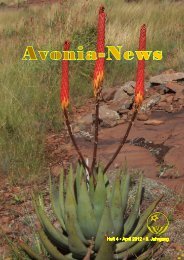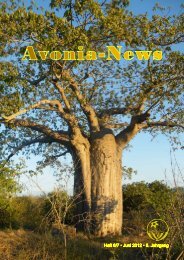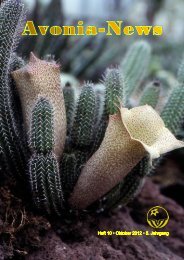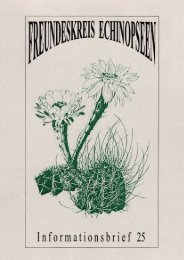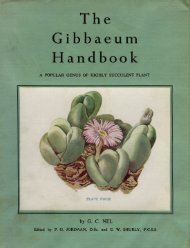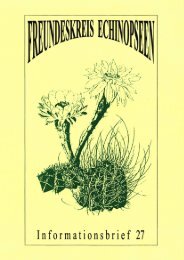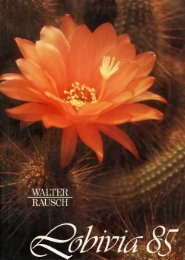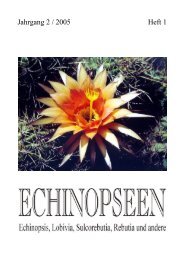journal
journal
journal
Create successful ePaper yourself
Turn your PDF publications into a flip-book with our unique Google optimized e-Paper software.
20 THE CACTUS AND SUCCULENT January, 1951<br />
SPINES<br />
By S. NAYLOR<br />
There is, in the majority of people, an innate desire to know the how and why of the things we are interested in.<br />
This urge is strongly present when contemplating the cactus on our greenhouse staging. The feature which<br />
has intrigued me of late is the spine or prickle (the latter being the word preferred by the botanist) in its many<br />
forms, colouration and orderly arrangement.<br />
Query after query present themselves to one's mind, such as, how are they produced and of what are they<br />
composed, when did they first appear, and what purpose or purposes do they serve ; where can one find the<br />
answer, or, at least, a reasonable explanation ? These and many more are the perplexities one has constantly<br />
before the mind.<br />
The growning glory of all vegetation is, undoubtedly, its flora, and the cactus is not behind any of them for<br />
beauty, but this beauty is fleeting and fades unseen by mortal eye in most cases. However, the resultant seed<br />
affects the perpetuation of its genera and the purpose is served.<br />
The Cactus Family has yet another glory not shared by any other botanical group, in which it is quite unique,<br />
namely, the production of spines, also of their nature and the orderly arrangement of them and in their presence<br />
on almost every species of the family.<br />
As with the flora, there is here, in the spine, also a beauty of colour and form, but, additionally, a symmetric<br />
pattern which holds the eye by reason of its outstanding effect. This order or precision of spine arrangement is<br />
produced by the even spacing on a spiral round the body of the area we designate as the areole (the root meaning<br />
is area).<br />
In some species, there is a single spiral and in others a number, progressing upwards together, or side by side.<br />
Compare the Pereskia, or one of the cylindrical Opuntias, with an Ech/nopsis, viewed from above, when the spirals can<br />
be best seen and counted.<br />
Spines only occur at the areole and in that area have a centre of growth of their own, as is demonstrated<br />
in the case of the Coryphanthanae. In this genera the flower appears in the axils of the tubercle, while the spines<br />
are at the tip or outer extremity, showing a division of two centres of production. With all other species, as far<br />
as I have been able to obssrve, the flower develops immediately above the spine cluster, as do also the offsets,<br />
so evident in some of the species. One peculiar aberration, recently noticed, was the development of an offset<br />
instead of a seed berry, with the tube of the flower encasing it. This was on a Mammillaria gracilis. The wool or<br />
hair, which adorns so many species at the areole, appear to serve the good purpose of protecting the flower and<br />
subsequent seed producing area, from knocks or sun scorching.<br />
The spine is a most remarkable production in that it is composed, in the main, of a form of silica and does not,<br />
when mature, contain any living cells, which fact accounts for its stiff, rigid toughness. Presumably these cells,<br />
having produced the spine, cease to live because their work is complete. Silica is a non-metallic element, very<br />
much like carbon and is very abundant in nature. Flint is one kind frequently seen. Silica is commonly present<br />
in varied rock formations and, mixed with their oxides, throughout the earth. As a result of this wide distribution<br />
in the soil, very minute particles are present in ground water and are absorbed, being found in large proportion in<br />
the flesh of the cactus.<br />
This otherwise useless constituent is employed to make the vulnerable spine and protective hair. This brings<br />
us, naturally, to a consideration of the obvious usefulness of the spine as a protective agent from grazing animals<br />
and of man, until he found the easy way of ridding himself of them by burning. They serve the useful purpose<br />
of providing shade from scorching sun and also act as a brake to searing wind. Possibly they also assist in the<br />
supply of water to the roots by conducting atmospheric moisture and naturally draining it downwards.<br />
Another self-evident use of the spine is presented in the remarkable barbed v/eapon of the Opuntiae. Having<br />
caught the fur or entered the flesh of an animal, the pad or broken branch is carried away for some distance before<br />
the tortured animal removes it by one means or another. There to lie and eventually root itself, so forming another<br />
colony. These remarks apply also to the hooked type of spine seen on some Mammillarias.<br />
Of the foregoing, that which is conjecture justifies itself, it seems to me, until some authority or authorities<br />
come to our rescue by producing an " a posteriori " such as we are looking for, which will satisfy our desires and<br />
add to the recorded knowledge of our subject.




